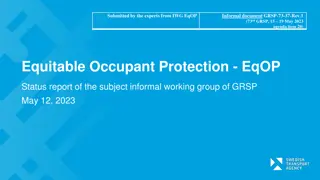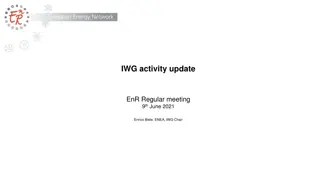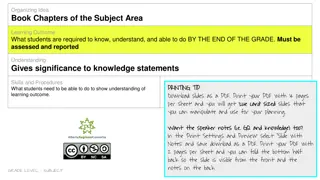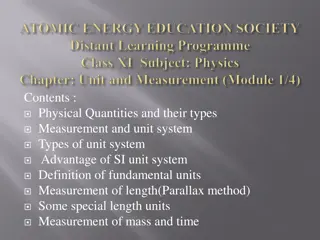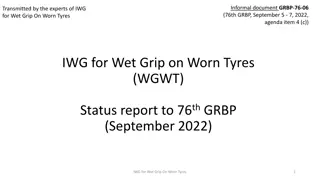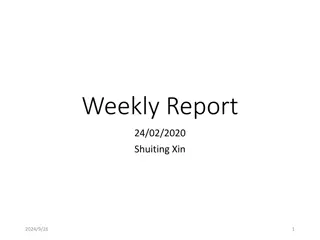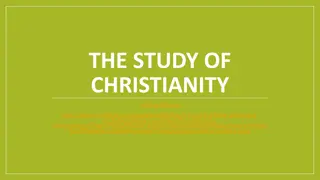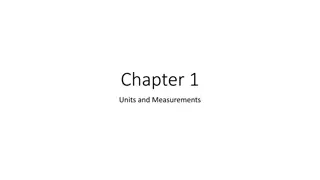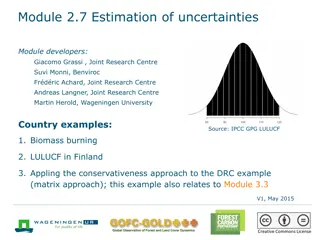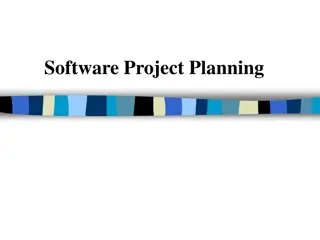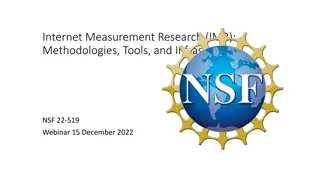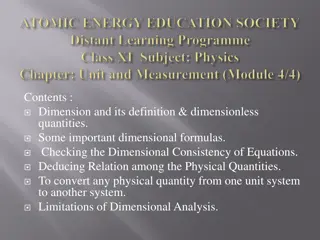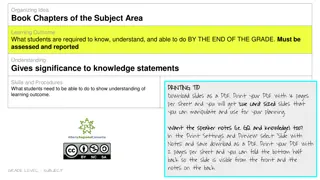IWG Measurement Uncertainties: Justification of Impact Quantities
Explore the justification of main impact quantities in IWG Measurement Uncertainties session held on 6th and 7th October 2020. The analysis includes factors such as deviation from centered driving, start of acceleration, speed variations, load variations, background noise, temperature effects on noise, humidity, altitude variations, and more. Various approaches like measurements, statistical methods, and theoretical derivations are used to assess the impact on Lurb situation input quantities. Numerous factors affecting the measurement results are considered to ensure accuracy and completeness.
- Measurement uncertainties
- Impact quantities
- Justification
- Statistical methods
- Theoretical derivations
Download Presentation

Please find below an Image/Link to download the presentation.
The content on the website is provided AS IS for your information and personal use only. It may not be sold, licensed, or shared on other websites without obtaining consent from the author. Download presentation by click this link. If you encounter any issues during the download, it is possible that the publisher has removed the file from their server.
E N D
Presentation Transcript
IWG Measurement Uncertainties 6th session 6/7 October 2020
Justification of the main impact quantities. Justification by different approaches: 1. by measurement (or simulation) results from specific experiments, e.g. investigations on power train noise at indoor test bench 2. by classic statistical methods e.g. parameter studies and correlation analysis (ACEA Tyre study) 3. by theoretical derivations based on physical relations e.g. distance law (deviation from centered driving)
Justification of the main impact quantities. estimated deviations of the meas. result (peak- peak) Justification by Impact on Lurb Situation Input Quantity Status Status of completeness: 100% statistical methods theoretical derivations measurement Lwot Lcrs Micro climate wind effect 0,40 0,77 0,53 done X DRIVER #1: Deviation from centered driving 0,50 0,50 0,50 done X DRIVER #2: Start of acceleration 0,50 0,00 0,33 done X Run to Run DRIVER #3: Speed variations of +/- 1km/h 0,30 0,30 0,30 done X DRIVER #4: Load variations during cruising 0,00 0,50 0,17 done X Varying background noise 0,10 0,10 0,10 done X Variation on operating temperature of engine (WOT) and tyres (WOT&CRS) ==> See ISO 362-1 NOTE 1,20 0,50 0,96 done X Barometric pressure (Weather +/- 30 hPa) 0,60 0,00 0,40 done X Air temperature effect on tyre noise (5-10 C) 1,00 2,00 1,34 done X Day to Day Air temperature effect on tyre noise (10-40 C) 1,00 2,00 1,34 done X Varying background noise during measurement 0,60 1,00 0,74 done X Air intake temperature variation 1,50 0,00 0,99 done X Residual humidity on test track surface 0,70 1,00 0,80 done X Altitude (Location of Test Track) -100 hPa/1000m (from 1015 to 915 hPa) 1,00 0,00 0,66 done X Test Track Surface 3,50 5,00 4,01 done X Site to Site Microphone Class 1 IEC 61672 1,00 1,00 1,00 done X Sound calibrator IEC 60942 0,80 0,80 0,80 done X Speed measuring equipment continuous at PP 0,07 0,13 0,09 done X Acceleration calculation from vehicle speed measurement 0,50 0,00 0,33 done X Production Variation on Tyres; Aging of Tyres until delivery to customer (1dB after one year) 0,75 1,50 1,00 done X Variation on Tyre Size and Brand (non-OEM) 0,00 0,00 0,00 Vehicle to Vehicle Production Variation in Power 0,40 0,00 0,26 done X Battery state of charge for HEVs (3 dB(A)) 0,00 0,00 0,00 Production Variability of Sound Reduction Components 1,00 0,50 0,83 done X Impact of variation of vehicle mass 1,40 0,60 1,13 done X
Justification of the main impact quantities. wind effect justification by measurement Wind speed within 5m/sec tolerance may affect acceleration performance. Normally its influence is not so significant, but we should know some vehicles have large impact. The example shows 1.6 dB(A) difference for Lurbanin the conditions of following and against wind. Against wind 5m/s Following wind 5m/s Sound Pressure level [dB(A)] 2ndgear Influence of k- factor SPLurban: 1,6 dB 3rdgear Acceleration [m/s2] A car with low PMR and large frontal projected area such as tall body shape is affected in acceleration during pass-by noise test by wind speed but sound pressure levels in cruise and acceleration are less changed by wind speed. The impact for the final result of Lurbanis 1.6dB.
Justification of the main impact quantities. DRIVER#1: deviation from centered driving justification by theoretical derivation Invers square law: center ??? = ? 10 7,5? + ? 7,5? log 3 with: x coefficient for dB/distance doubling deviation from center deviation from center x ??? = ? 10 7,5?+?,?? 7,5? = 0,5dB 3 log SPLurban: 0,5 dB Assumption for the calculation: 5dB/distance doubling (monopole source under semi-free field conditions) and 0,5m for the deviation from center.
Justification of the main impact quantities. DRIVER#2: start of acceleration justification by measurement SPLwot =0,6 dB SPLurban: 0,3 dB preacceleration [meter bevor line AA]: -5m/-3m The variation of the point of push down gas pedal causes different accelerations and a different sound emission in the wot measurement.
Justification of the main impact quantities. DRIVER#3: speed variations of +/- 1km/h justification by theoretical derivation SPLtyre road noisevs. vehicle speed (derived from R117) ? ??????= ? + ? log 50??/ ??????~ log ? with: b SPLTRN@50km/h coefficient for speed dependency 51 49= 0,5dB ??????= ?? log SPLurban: 0,5 dB Assumption for calculation: mean coefficient of the speed dependency is 30 (usually varies between 27 - 33 for C1 tyres). Depending on the source distribution this effect influences the test result of crs and wot measurement.
Justification of the main impact quantities. DRIVER#4: Load variations during cruising justification by statistical methods SPLurban: 0,3dB ( SPLcrs:1.0dB) A constant speed test is considered valid, if the vehicle speed does not change by more than 1 km/h around the vehicle target speed of 50 km/h. The tables above provide a calculation scheme for the 3rd(left table) and the 4thgear (right table). Per gear three columns are shown. Column 1 is a run, with 50 km/h throughout the test area. Column 2 is an acceleration from the lower border vehicle speed to the upper border vehicle speed. Column 3 is almost a free rolling from the upper border speed to the lower border speed. The calculations of the sound source tyre/rolling sound (Ltr,50) and the mechanics/dynamic sources (Ldyn) are done according to the RD-ASEP model with a split of 90% tyre rolling sound and 10% for the remaining sources. The impact on Lurban is estimated by a 1/3rdshare of the cruise test to the overall result.
Justification of the main impact quantities. Varying background noise justification by measurement 16 dB(A) 14 dB(A) SPLurban: 0.0 0.4 dB Background shall be measured before and after a serious of measurements. During a measurement it is not possible to determine the background noise. While the background noise might be low during its measurement, transient broadband events with up to 60 dB(A) may occur. Such events are typical for test centers with multiple tracks and events, but hardly noticeable during pass-by measurements. These transient noises will be counted as vehicle signal and can especially affect cruise measurement up to 1.0 dB to 1.2 dB higher values. In a 1/3rdshare of the cruise test to Lurban, the impact on Lurban is estimated up to 0.4 dB.
Justification of the main impact quantities. variation on operating temperature of engine and tyres justification by measurement Variation of approx. 100 C on exhaust system (KAT Temp.) + Variation of 10 C test track temp (derived from R117) SPLurban: 0,8 dB High-performance vehicles in particular can have a large dependency on component temperatures of the power train. Here, too, the source distribution decides how large the influence on the end result is.
Justification of the main impact quantities. barometric pressure justification by theoretical derivation Barometric Pressure Power variation 7.7% Acceleration variation 7.7% Lurban [dB(A)] 0.4dB Weather +/- 30 hPa Day to day 60hPa Site to site Altitude -1000m Location of Test Track 100hPa 13.5% 13.5% 0.7dB 74 73 72 dB(A) ISO1585 paragraph 6.3.1 Correction of engine power; Correction factor for spark-ignition engines; 71 70 P= ?? Sound Pressure Level 69 68 SPLurban: up to 0,7 dB 67 66 65 64 1.2 0.6 ???? ? ? 63 ?= 62 a_urba n a_wot ???? 61 60 0.0 0.2 0.4 0.6 0.8 1.0 1.2 1.4 1.6 1.8 2.0 2.2 2.4 2.6 2.8 3.0 Acceleration m/s2 The influence of barometric pressure can be calculated by using ISO 1585 Engine test code Net Power (or R85)
Justification of the main impact quantities. Air temperature effect on tyre noise (5-10 C) justification by measurement Air temperature effect on tyre noise (10-40 C) justification by measurement/ calculation Extrapolation (upper temp. range) of the measured SPL by a logarithmical fitting function (derived from temperature correction of the R117 for C1 tires) with using the air temperature. extrapolation 3,3dB SPLCRS: 5 dB SPLWOT: 3.2 dB -1,7dB SPLurban: 3.8 dB The influence of the air temperature on the tire/ road noise can be up to 5dB within the total temperature range from 5 up to 40 C. For Lcrs 100% contribution of tire noise is considered and for LWOT 50% contribution of tire noise is considered.
Justification of the main impact quantities. Varying background noise during measurement justification by redundant see slide Varying background noise (no. 5)
Justification of the main impact quantities. Intake temperature justification by measurement Air temperature range (The regulation allow tem- perature condition at 5 to 40 .) 35 1 ~ 1.5dB /20 Estimation of the impact on Lwot Impact of Intake noise against intake temperature (Decreasing by 20 provides increasing of intake noise by 1 to 1.5dB based on measured data.) +2.8dB Relation between air- and intake temperature (at least increasing by 10 at higher temp.)) 10 2.25~3.38dB Total range of intake temperature (5 to 50 ) 45 Ave. 2.8dB 1.6dB Intake temp. Impact to Lwot Impact to intake noise [ ] E.g. Staying idle for 5 minutes provides intake temperature increases by 10 . SPLurban: 1 dB time [min.] Temperature effect for Lcrs and Lwot for tyre noise are covered in Air temperature effect on tyre noise . Therefore temperature effect for Lwot for power train noise is considered here. The temperature effect for intake noise is used measured data. Same impact of air (gas) flow excitation to exhaust etc. are considered. The contribution of sound level provided by such excitation is assumed by 50% for calculation of Lwot.
Justification of the main impact quantities. Residual humidity on test track surface justification by measurement 0,9 0,7 1,7 2,1 SPLurban: 1 1,3 dB 3 Measurements in each operating condition, Runs with residual humidity: test track surface between AA and BB almost 100% dry All measurements performed on the same day according to R51.03, Annex 3 (Tyre dimensions: 285/40 ZR21; 315/35 ZR21) Residual humidity on one side of the line CC only can lead to Run-to-Run deviations
Justification of the main impact quantities. Altitude (Location of Test Track) -100 hPa/1000m (from 1015 to 915 hPa) justification by redundant see slide Barometric pressure (no. 7)
Justification of the main impact quantities. Test track surface justification by measurement (VDA RR) Maximum deviation track: 5,5 dB max. deviation vehicle measurement: 4dB 69.0 68.0 67.7 66.7 67.0 67.4 SPL [dB(A) 66.0 66.5 65.0 64.3 64.0 63.0 63.4 61.6 62.0 61.0 61.0 60.0 0 0.5 1 1.5 2 acc. [m/s^2] SPLurban: 4 dB Test track min Test track max Lroll min Lroll max Linear (Test track min) Linear (Test track max) Different test tracks surfaces lead to different tyre road noises. Depending on the source distribution these differents influence the test result of crs and wot measurement.
Justification of the main impact quantities. Microphone Class 1 IEC 61672 justification by measurement (calibration) SPLurban: 1 dB 5000 Hz The deviation from reference of today used microphones is normally in a range of +/- 0.5 dB. The maximum error during measurement by using two different sound level meters can be up to 1 dB. The frequency range of interest of pass by test is up to 5000 Hz (example in the left diagram, 99% of the OAL @5000Hz)
Justification of the main impact quantities. Sound calibrator IEC 60942 justification by measurement (calibration) SPLurban: 0,5 dB The maximum allowed deviation determined by DIN EN 60942:2018 Electroacoustics. Sound calibrators is +/- 0.25 dB. The maximum error during measurement by using two different sound calibrators can be up to 0.5 dB.
Justification of the main impact quantities. speed measuring equipment at PP justification by theoretical derivation Same approach as DRIVER#3: speed variations of +/- 1km/h Precision of todays speed measuring systems: approx.: +/-0,2 km/h 50,2??/ 49,8??/ = 0,1dB ??????= ?? log SPLurban: 0,1 dB See DRIVER#3: speed variations of +/- 1km/h
Justification of the main impact quantities. Acceleration calculation from vehicle speed measurement justification by theoretical derivation GEAR i GEAR i+1 GEAR i GEAR i+1 60 Power-to-Mass Ratio PMR 60 Power-to-Mass Ratio PMR 60 Power-to-Mass Ratio PMR 60 Power-to-Mass Ratio PMR 1,42 Reference Acceleration [m/s ] 1,42 Reference Acceleration [m/s ] 1,42 Reference Acceleration [m/s ] 1,42 Reference Acceleration [m/s ] 1,80 Acceleration Gear i 1,30 Acceleration Gear i 1,80 Acceleration Gear i 1,30 Acceleration Gear i 0,5 Speed Precision [km/h] 0,77 Gear Weighting Factor k 0,5 Speed Precision [km/h] 0,77 Gear Weighting Factor k Vehicle Speed at AA, BB, PP Acc [m/s ] Error Vehicle Speed at AA, BB, PP Acc [m/s ] Error Vehicle Speed at AA, BB, PP Acc [m/s ] Error Vehicle Speed at AA, BB, PP Acc [m/s ] Error AA PP BB+5m AA-BB+5m [%] AA PP BB+5m AA-BB+5m [%] AA PP BB+5m AA-BB+5m [%] AA PP BB+5m AA-BB+5m [%] 45,1 56,6 46,5 54,8 50,0 1,80 Ref 50,0 1,30 Ref 45,1 56,6 46,5 54,8 50,0 1,80 Ref 50,0 1,30 Ref Both devices measure too high values 1,0 45,6 50,5 57,1 47,0 50,5 55,3 A 1,82 1,0 1 1,31 1,0 Both devices measure too high values 45,6 50,5 57,1 47,0 50,5 55,3 A 1,82 1,0 1 1,31 Both devices measure too low values 1,5 44,6 49,5 56,1 45,7 49,5 54,1 B 1,78 1,0 2 1,28 1,5 Both devices measure too low values 44,6 49,5 56,1 45,7 49,5 54,1 B 1,78 1,0 2 1,28 Diametrical error AA low and BB high 12,0 44,6 50,0 57,1 46,0 50,0 55,3 C 1,96 8,7 3 1,46 12,0 Diametrical error AA low and BB high 44,6 50,0 57,1 46,0 50,0 55,3 C 1,96 8,7 3 1,46 Diametrical error AA high and BB low 12,0 45,6 50,0 56,1 47,0 50,0 54,3 Diametrical error AA high and BB low 45,6 50,0 56,1 47,0 50,0 54,3 D 1,64 8,7 4 1,14 12,0 Gear Mix D 1,64 8,7 4 1,14 Gear Mix 0,5 dB Combination C-3 Combination C-3 C 1,96 3 1,46 i+1 only C 1,96 3 1,46 i+1 only Combination C-4 Combination C-4 C 1,96 4 1,14 0,66 C 1,96 4 1,14 0,66 Combination D-3 Combination D-3 D 1,64 3 1,46 i+1 only D 1,64 3 1,46 i+1 only Combination D-4 Combination D-4 D 1,64 4 1,14 0,45 D 1,64 4 1,14 0,45 SPLurban: 0,5 dB The acceleration is derived by calculation from the speed measurement. The speed measurement shall be determined with devices according to is subject to uncertainty and given by the regulation according to paragraph 1.4 of Annex 3 of UN R51.03. The tables and the figure show the impact of the allowed speed uncertainty on the final test result.
Justification of the main impact quantities. Production variation on tyres; Aging of tyres until delivery to customer justification by measurement aging: + prod. variation: 1 dB/ year production variation 0,5 dB 1,5 dB (CRS) = SPLurban: up to 1dB aging The variation of 0,75 dB in WOT measurement assumes a source distribution of 50% between tyre road and power train noise.
Justification of the main impact quantities. Production variation in power justification by theoretical derivation Power variation Power variation absolut Acceleration variation Lurban [dB(A)] approach similar to barometric pressure +/- 5% 10% 10% 0.4dB 0,2 m/s2 0,4 dB SPLurban: up to 0,4 dB Based on a allowed production variation in power of +/- 5% and a total variation in acceleration of 10% the impact on Lurban is up to 0,4 dB.
Justification of the main impact quantities. Production Variability of Sound Reduction Components justification by measurement tailpipe noise Variation up to 2dB deviation [dB] SPL [dB(A)] Measurement of 7 exhaust systems from the same type SPLurban: up to 0,7 dB rpm [1/min] rpm [1/min] The impact on Lurban of 0.7 dB assumes a contribution of the effect of 50% on Lwot (1.1dB). The effect in the Lcrs is neglectible.
Justification of the main impact quantities. variation vehicle mass justification by measurement (simulation) argumentation chain: test gear change test gear engine speed mFZG a SPL SPL =1,6dB vehicle mass + 200kg (appr. + 11%) gear i becomes valid gear i+1 normal vehicle mass The main impact of the variation of the vehicle mass is on acceleration behavior and can causes a test gear change. The test gear change leads to an other test engine speeds and an other sound emission.


